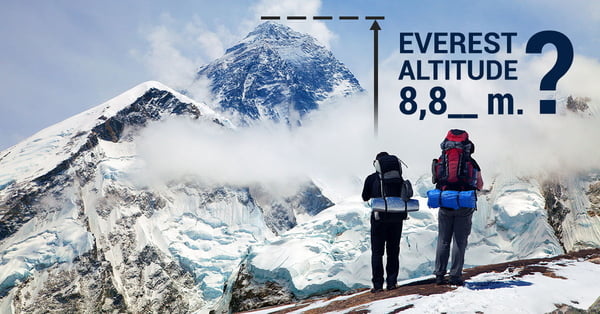
Mountaineering
BeginnerHiking
BeginnerRock Climbing
BeginnerIce Climbing
BeginnerBackcountry Skiing
BeginnerMountain Planet
12 years, Australia
Everest Altitude Measurement History: Check Yourself!
Everest is the center of attention again: during the spring season, 2019, more than 10 people deceased while climbing the highest mountain of the world... Stop-stop — and is Chomolungma the MOST high mountain of the world? And how much should one be sure of its altitude? This is the opinion of Yury Molodtsov — read the history of Mount Everest highness changing from the 19th century to present day. Everest Base Camp. Photo: Michael Clarke for Unsplash Author Yury Molodtsov, 26 y.o., land surveying degree. Since 2012 work in the field of geodesy, from 2015 — employee of HEXAGON company (Russian office) with the connection to Leica Geosystems, well-known in geodesic circles. In 2018 Yury became interested in alpinism and in July, 2018 climbed Elbrus; in February, 2019 — Kilimanjaro. In July, 2019 he plans to ascend Mont Blanc, and in August/September, 2019 — Kazbek (Georgia). Yury’s professional activities together with hobbie have developed an interest to the history of determining the heights of 7 Summits by geodetic methods.


Sweet mount of mine
For the first time the measurements of Himalayas’ peak altitude were documented by the Prussian geographer Alexander von Humboldt, at the beginning of the 19th century (he was one of the founders of geography as a science). In 1816, Alexander compiled reports on Himalayan peaks calculation, using barometric measurement methods that employ barometers to determine elevation relative to sea level.
Simultaneously with the Humboldt survey, William Lambton and George Everest (the founders of the The National Survey and Mapping Organisation — Survey of India) conducted the Great Trigonometric Survey, which had great scientific value. Among the many achievements of the project, one can note the demarcation of British Territories in India and measurements of Himalayas’ peaks, including Chomolungma, Chogori (K2) and Kanchenjunga.
Using data, collected during the study under the direction of Andrew Scott Waugh (Head of the Geodesic Service of India after George Everest) Himalayan peaks were measured using optical instruments. Thus, it turned out that Peak No. 15 (Peak XV), also known as Everest, had an altitude of 29,002 feet (8,840 meters above sea level).

Pic.1. The table of calculation of Mount Everest altitude from 1849 to 1902.
In 1849 — 1850, measurements of the summit were carried out from stations, situated on the flat terrain. A refractive index of 0.07–0.08 was used for it. The average of test results was 29,002 feet (8,848 meters) — does it sound familiar? Later, starting from 1881, the measurements had been taken from stations, situated on upland, with a refraction index of 0.05. The result of these measurements complied 29,141 feet (8,882 m).

Pic.2. Himalayan peaks altitude measuring scheme with triangulation points.
30 years later, or calculate and recalculate!
30 years later, elevation values were recalculated under the direction of Survey of India Service relative to sea level, and more accurate measurements were performed in 1954, taking into account such factors as atmospheric corrections, deviations from a plumb line, geoid elevation, etc.
Thus far, the altitude of Mount Everest summit has been measured by various methods: optical-electronic, satellite (GNSS — Global Navigation Satellite System), photogrammetric and even scanning from the aircraft. Obviously, the most reliable data were obtained using satellite observation methods.
In 1992, the Italian expedition raised the Leica GPS200 satellite receiver to the top of Jomolungma and collected geospatial data right there.
Do surveyors dream about altitude?
It is worth noting that in geodetic science there are several systems of geodesic heights:
- Orthometric elevation and geoid elevation
- Normal height and height anomaly (quasigeoid elevation)
- Normal orthometric elevation and cogeoid elevation.
In order to measure the height relative to the average sea level, the scientists use the concept of so-called geoid — to set a reference plane. Points coordinates on Earth's surface are measured relative to ellipsoid — the surface in three-dimensional space, obtained by deforming the sphere along three mutually perpendicular axes. The difference between geoid and ellipsoid altitudes is called a “height anomaly”. The value of height anomaly deverge at different points on Earth's surface. In Everest region, the height anomaly count from -25 m to -35 m. As it can be seen on Picture 3, the values of height anomalies in Everest Base Camp and on the summit are different.

Pic. 3. Height anomalies at various grid stations in Mount Everest region.
And yet... the data does not match?
During last 50-70 years (thanks to the development of modern science and new methods of geodetic research), correct values of local and global geoids in Everest Region were calculated. However, different groups of scientists from various countries get vary values, from -35.05 m to -25.14 m.
Scientists also raised another important issue, concerning the determining of Mount Everest altitude, — the thickness of the snow cap at the summit. In 2004, Italian expedition raised to the top a special georadar, combined with the GNSS (Global Navigation Satellite System), developed by University of Trieste. This device was used to determine the depth of snow, which cover various points of the summit.

Pic. 5. Operator works with georadar on the slope of Everest.

Pic. 6. Side-drown schematic representation of the summit.
As a result of data, collected by Italian expedition with the usage of satellite equipment and georadar, following outcome had been obtained.
|
Latitude |
Longitude |
Altitude |
|
|
Snow summit |
27᷾°59’16,963’’ |
85°55’31,736’’ |
8848,36 |
|
Rock summit |
27°59’16,998’’ |
85°55’31723’’ |
8845,32 |
Table 1. The coordinates of Mount Everest summit.
Don’t worry, we’ll measure again!
As a conclusion, worth saying that today there are a lot of geodesic methods, by which it is possible to determine the height of Everest summit (or other mountain) with different accuracy. Most likely, the combination of satellite methods with georadar allows to achieve the most accurate results in these surveys.
But nevertheless, according to some publications, the Ministry of Land Management of Nepal (together with one of the major manufacturers of geodetic equipment) plans to conduct another expedition, within which the height of top of the world will be redefined once again. Well, good luck!
Bibliography
1. Giorgio Poretti. “Is Mount Everest higher than 155 years ago” — taken as the basis for this article.
2. Gulatee B. L. 1954. The Height of Mount Everest. A new determination (1952-54). Survey of India Techn





